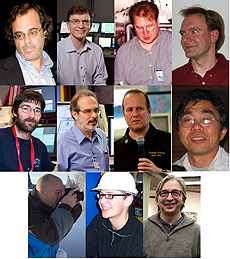Flipping the magnets (not the burgers)
 |
| Similar to the way that flipping a burger ensures all parts of the patty have been exposed to heat, flipping the magnetic field direction in DZero provides protection against unwanted effects of detector nonuniformities. Photo: Mike |
Several recent DZero results have involved the production of a particle and its antiparticle and their directional tendencies.
The Tevatron collided oppositely directed protons and antiprotons. Sometimes a particle created in the collision exited in the direction of the incoming proton while its oppositely charged antiparticle emerged in the direction of the incoming antiproton. Sometimes the situation was reversed. The difference in these configurations is usually cast in terms of a forward-backward asymmetry, where "forward" refers to the first situation and "backward" to the second.
In the case of top and antitop quark production, the measured asymmetry originally seemed to be larger than expected, which if true would have signaled some new physics. (Later measurements resulted in better agreement with the Standard Model predictions.) Subsequently scientists sought such asymmetries in the production of particles containing bottom quarks. Further studies of asymmetries involving the decay products of Z bosons or muon pairs allowed further sensitive tests of the Standard Model.
In all of these measurements, the effects caused by asymmetries in the detector itself must be minimized. But measuring these accurately is nearly impossible.
In controlling detector asymmetries, DZero has a unique secret weapon. As with other collider experiments, DZero has a magnet surrounding the inner detectors that record the curving particle tracks. Unlike other experiments, DZero was able to reverse this magnetic field.
Reversing the magnet polarity is no big trick: One simply throws a giant switch. But most detectors measure particle trails in a gas, and this only works with one magnet polarity. In DZero's case, there were no gas-filled tracking detectors. Instead it relied on thin layers of silicon or scintillator, which are nearly insensitive to the magnetic field direction. The DZero magnet was reversed every two weeks with equal data samples for each.
The reversal allows for almost complete cancellation of the asymmetries caused by detector effects. The reason is easy to see if one considers two possible event configurations for producing a particle and its oppositely charged antiparticle: In one, the positive particle travels in the forward direction in a positive magnet polarity, and the negative particle travels in the backward direction. In the second, the negative particle travels in the forward direction in a negative magnet polarity, and the positive particle travels in the backward direction.
These two configurations interchange the "forward" and "backward" categories. But the positive particle in the positive polarity field travels on the exact same trajectory as the negative particle in the negative polarity, and thus their detection efficiencies should be essentially the same.
This pairing of equivalent configurations assures that the effects of the forward-backward instrumental asymmetries are nearly canceled.
Like flipping the burgers, flipping the magnets assures uniform cooking!
—Paul Grannis
 |
| Keeping the Run II DZero experiment running smoothly around the clock required close supervision of magnets, detectors, electronics, cryogenic and safety systems. The Run II run coordination team included, top row, from left: Jon Kotcher, Dmitri Denisov, Alan Stone, Arnd Meyer. Middle row, from left: Michele Weber, George Ginther, Bill Lee, Taka Yasuda. Bottom row, from left: Norm Buchanan, Marc Buehler and Stefan Gruenendahl. |
|